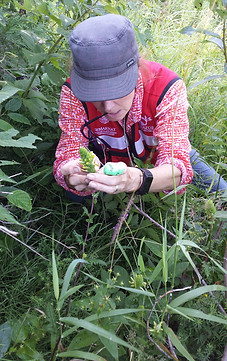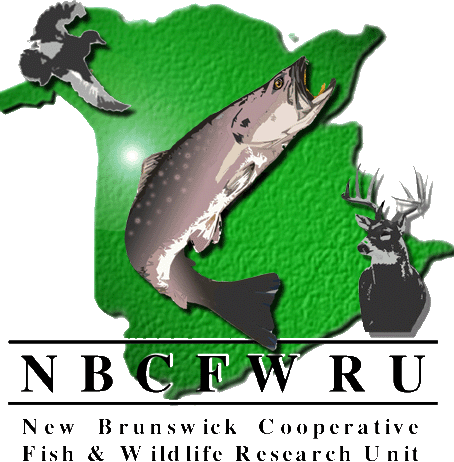Furbish's Lousewort (Pedicularis furbishiae)

G. Forbes

COSEWIC 2000

G. Forbes
Figure 1. Furbish's Lousewort, left) flowering, middle) full plant, right) flower. Left and right photo by G. Forbes, middle photo by COSEWIC (2000).
Fun Facts
-
Furbish’s Lousewort was the first plant to be designated as endangered nationally (by the Committee on the Status of Endangered Wildlife in Canada, 1980) and provincially (under the New Brunswick Endangered Species Act, 1982).
-
This species is named after Kate Furbish (Figure 2), an incredibly talented female botanist from New England who first described the plant to science. Read more in this article written by Bridget Macdonald from the US Fish & Wildlife Service titled It’s not just Furbish’s Lousewort. It’s Kate Furbish’s Lousewort.

Old Berwick
Historical Society
Figure 2. Kate Furbish.
Description
Furbish’s Lousewort is a perennial herbaceous, hemi-parasitic plant that occurs on the periodically flooded shores of the upper St. John (Wolastoq) river. Hemi-parasitism means that the roots attach to the roots of other species, stealing nutrients from that host plant. Furbish’s Lousewort is a member of the snapdragon family and is recognizable by its basal rosette of fern-like leaves and one or more upright flowering stems when mature. Plants mature after several years and grow to about 1 m tall. Toward mid-summer, mature plants produce one or more flowering stems. The stems have widely spaced leaves and are topped by a tight cluster of small, yellow, tube-like flowers, which bloom only a few at a time. A distinguishing feature that separates this species from other lousewort species is deeply incised leaflets on the lower leaves (Figure 3).

Figure 3. Furbish's Lousewort with deeply
incised leaflets on lower leaves.
What's in a name
Pedicularis, the genus name of Furbish’s Lousewort, is derived from the Latin pediculus, meaning ‘louse’. ‘Wort’ is from the old English, with ‘wyrt’, meaning plant. Old beliefs either had lousewort giving lice to people and cattle, or curing people and cattle of lice (U.S. Fish and Wildlife Service 2005). As noted briefly above, Furbish’s Lousewort was first described to science in 1880 by Kate Furbish, a botanical artist and naturalist, and confirmed in 1882 by Sereno Watson, a Harvard University botanist who named the plant Pedicularis furbishiae in honor of its discoverer (U.S. Fish and Wildlife Service 2005).
Distribution
Furbish’s Lousewort is globally restricted to the St. John (Wolastoq) River Valley in northern Maine and northwestern New Brunswick (Figure 4). Its known distribution consists of a 225-km section of the Saint John River extending from above the confluence with the Big Black River in Maine, United States to the confluence with the Aroostock River, approximately 1 km north of Perth-Andover, New Brunswick (Stirrett 1980).

Figure 4. Global range of Furbish's Lousewort. Photo from Environment Canada (2010).
Habitat
Furbish’s Lousewort occupies habitats that are periodically disturbed. They are mainly confined to a shrub-dominated zone on a riverbank below conifers and deciduous hardwoods and above a cobble zone with sparse herbaceous vegetation (Stirrett 1980; Figure 5). It prefers calcareous, well-drained, sandy loams of river terraces subject to erosion by high water and ice below, and from landslides above (Stirrett 1980). Its placement along riverbanks endures the brunt of ice scour during high-water spring runoff. This prevents tree establishment and ultimately controls shrub dominance (Day 1983).

G. Forbes
Figure 5. Furbish's Lousewort typically growns along a drip line where forest meets the ground vegetation
Biology
The Furbish’s Lousewort is pollinated by bees. Only one species of bee, the Half-Black Bumblebee (Bombus vagans; Figure 6) has been recorded to pollinate the flowers (Macior 1980). The plant produces seeds in late summer and early fall; these seeds are transported by water (Macior 1980). Their small size and outer seed coat enables them to float in water for several days (Macior 1980).

Figure 6. Half-Black Bumblebee (Bombus vagans). Photo by USGS Bee Inventory and Monitoring Lab.
Conservation
Furbish’s Lousewort is a listed species for four main reasons: 1) it only occurs at 5 sites in Canada, 2) the number of plants at each site is low (as few as 2, and no more than 75), 3) the overall population size has been declining, and 4) the threats continue. The biggest threat is the increasing strength of the St. John (Wolastoq) River. This is causing large sections of the river to erode, massive slumping, and also removing soil along the shoreline. Loss of soil is a large impact as the plant does not grow on bare rock. A historically healthy site with 100 plants has declined to only have 3-4 plants today, and recovery is unlikely as there is almost no soil remaining.
The protection of the existing sites is the starting point for the conservation of Furbish’s Lousewort. In conjunction with property owners, we are assisting in the creation of site management plans. A program to encourage stewardship and volunteers is proposed for addressing specific challenges for each site.
An immediate push for exact site mapping of the plant’s location and similar habitats is necessary for effective conservation. The promotion of initiatives to raise awareness of existing laws and regulations will need immediate attention as well. Continuous monitoring and surveys will ensure that population trends are tracked and threats are identified as they emerge.
Research conducted in Maine has benefited conservation work in New Brunswick on aspects such as habitat requirements, population dynamics, and reproductive ecology. However, an action plan needs to be developed and implemented to provide context about questions and research priorities.
Stewardship and education for the general public should continue to be significant components in the conservation of Furbish’s Lousewort.

G. Forbes
Figure 7. Dr. Beardmore counting seed capsules at a site in August 2018
Helpful Practices for Everyone
-
The plants occur mainly on slope edges of the St. John (Wolostoq) River. Although specific locations are not advertised, it is helpful to generally avoid disturbing the slope section of the shore. Avoid taking ATVs or other vehicles off the rocky shoreline and onto the vegetated slopes. Erosion of slope is a concern for existing plants, and would lessen sites for future plants to grow in that site.
-
It is illegal to pick Furbish’s Lousewort; any plants should be left on the site. Avoid stepping in the area because young plants are hard to spot and could be damaged, and compaction could affect new plants from establishing.
Helpful Practices for Landowners
-
If plants exist on your property, it is hoped that landowners can work with provincial and/or non-government conservation agencies, such as the Nature Trust of New Brunswick, towards a cooperation on how to maintain the species. The plant does not grow far from the steep slopes of the River, and landowner activities generally are far from the plants.
-
Given the locations of the plant there is not expected to be much conflict between landowner land use and the plants. However, any activities that lead to erosion above the plants would be of concern; water flow above the plants could be altered by road construction, cement infrastructure or drainage pipes, potentially resulting in mass slumping events that would destroy the plants belong
-
if you suspect you have Furbish’s Lousewort on your property, please contact the provincial Department of Natural Resources and Energy Development.
Thanks!!
References
-
Committee on the Status of Endangered Wildlife in Canada. 2011. COSEWIC assessment and update status report on the Furbish’s Lousewort Pedicularis furbishiae in Canada. Committee on the Status of Endangered Wildlife in Canada, Ottawa, Ontario. vii + 13 pages.
-
Day, R. 1983. A survey and census of the endangered Furbish Lousewort, Pedicularis furbishiae, in New Brunswick. Canadian Field-Naturalist 97:325-327.
-
Furbish’s Lousewort Recovery Team. 2006. Recovery strategy for Furbish’s lousewort Pedicularis furbishia in New Brunswick. New Brunswick Department of Natural Resources. Fredericton, New Brunswick.
-
Macior, L.W. 1980. The population biology of Furbish's Lousewort. Rhodora 82:105-111.
-
Stirrett, George M. 1980. Status report on Endangered Wildlife in Canada: Furbish's Lousewort. Unpublished report, Committee on the Status of Endangered Wildlife in Canada.
-
U.S. Fish and Wildlife Service. 2005. Furbish Lousewort Pedicularis furbishiae. Northeast Region U.S. Fish and Wildlife Service.

